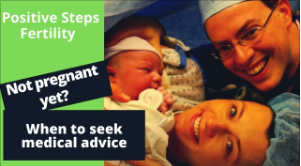By Dr. Preston Parry
When people hear the words “ovarian cyst,” it’s easy to worry. But not all cysts are dangerous, and many are actually a normal part of your body’s rhythm. Some cysts go away on their own. Some stick around a little longer. And very few need serious intervention.
As a fertility specialist, I talk to women all the time who are worried about cysts:
- What are they?
- Can they stop me from getting pregnant?
- Should I be scared?
Let’s walk through this carefully. The word cyst is used for a lot of different things, and not all cysts mean the same thing.
What Are Ovarian Cysts?
An ovarian cyst is a fluid-filled sac that forms either on or inside your ovary. Some cysts are small and go completely unnoticed. Others can grow larger—sometimes even as big as an orange—but most of them don’t cause long-term problems.
Many ovarian cysts are functional cysts, which simply means they are part of your body’s natural process. These types of cysts come and go as part of your menstrual cycle and often don’t need any treatment.
Ovarian Cysts vs. PCOS
One thing I always want to clear up: having an ovarian cyst is not the same as having polycystic ovarian syndrome (PCOS).
PCOS is a hormonal condition where your ovaries collect many small, immature follicles (tiny fluid-filled sacs that hold eggs). These follicles are usually less than 10 millimeters in size and tend to stall instead of growing to release an egg. PCOS affects your ovulation pattern, but it does not involve large cysts that need to be removed.
What Causes Ovarian Cysts?
Ovarian cysts can form for several reasons, and most are harmless.
The most common causes include:
- Ovulation: Each month, your ovary grows a follicle to release an egg. Sometimes, that follicle doesn’t open as expected or doesn’t dissolve properly after ovulation, and it fills with fluid, creating a cyst.
- Hormonal imbalances: Conditions like PCOS or the use of fertility medications can cause multiple cysts to form.
- Endometriosis: This is when tissue similar to the lining of the uterus grows outside the uterus, sometimes on the ovary, forming painful cysts called endometriomas.
- Pelvic infections: Severe infections can spread to the ovaries and create cysts.
- Abnormal tissue growth: Dermoid cysts and cystadenomas are examples of growths that develop from unusual tissue, though these are much less common.
How Do Ovarian Cysts Form?
Let’s break down how different types of ovarian cysts form in the body.
- Follicular cysts: Each month, your body prepares a follicle to release an egg. Sometimes, the follicle doesn’t open as expected, and instead of releasing the egg, it closes back up and fills with fluid. This forms a follicular cyst.
- Corpus luteum cysts: After the follicle releases the egg, it transforms into something called the corpus luteum. This is a temporary structure that produces the hormone progesterone, which your body needs to support the early stages of pregnancy. Sometimes, the corpus luteum seals off and fills with fluid, forming a corpus luteum cyst.
- Dermoid cysts: These are unusual cysts that develop from egg cells and can grow into many different tissue types. Because of this, dermoid cysts can contain skin, fat, hair, or even teeth.
- Endometriomas: These form when tissue similar to the lining of the uterus (endometrial tissue) grows on the ovary and gets trapped, forming what’s sometimes called a “chocolate cyst” because of the dark, old blood content inside.
- Cystadenomas: These grow on the surface of the ovary and are filled with watery or mucous-like fluid. They can sometimes grow quite large but are usually not cancerous.
What Makes Ovarian Cysts Grow?
Several things can cause a cyst to get larger:
- Hormonal activity: Sometimes your body continues producing hormones that encourage the cyst to grow.
- Pregnancy: Some cysts naturally persist during pregnancy and can take longer to resolve.
- Failure to dissolve: Most cysts shrink and disappear on their own, but occasionally, they linger and slowly increase in size.
- Endometriosis or abnormal tissue growth: These types of cysts often stick around and may grow larger over time.
Where Are Ovarian Cysts Located?
Ovarian cysts can grow inside the ovary or on its outer surface. You can have a cyst on one ovary, both ovaries, or sometimes multiple cysts at the same time. Some are deep within the ovary’s tissue, while others form more like bubbles attached to the outside. The location can sometimes affect whether a cyst causes discomfort or whether we need to follow it more closely.
How Does a Woman Know If She Has an Ovarian Cyst?
The honest answer is that many women don’t know they have one. Most ovarian cysts cause no symptoms and are only discovered during a pelvic exam or an ultrasound done for another reason.
When cysts do cause symptoms, here’s what you might experience:
- Pelvic pain or pressure, often on one side
- A dull ache in your lower back
- Bloating or a feeling of fullness in the lower abdomen, especially if the cyst is large
- Pain during sex
- Irregular or painful periods
- Frequent urination or difficulty fully emptying the bladder
- Trouble having a bowel movement (constipation)
Some women notice that these symptoms come and go, while others feel discomfort more consistently. You can also have a cyst and feel nothing at all. Or you might feel some of these symptoms and not have a cyst at all. That’s why we always rely on ultrasound to know for sure.
A Quick Note on PCOS Symptoms
When symptoms like irregular periods, weight changes, and skin changes linger over time, this could point to polycystic ovary syndrome (PCOS).
PCOS is a hormonal condition where the ovaries collect many small, immature follicles that don’t release eggs regularly. PCOS symptoms can include:
- Irregular menstrual cycles
- Difficulty getting pregnant
- Unexplained weight gain that’s often stubborn and hard to lose
- Cystic acne or oily skin
It’s important to understand that PCOS does not involve large, concerning cysts. The name is confusing—what we see in PCOS are small follicles that aren’t growing or ovulating as they should.
How Are Ovarian Cysts Diagnosed?
When we think there might be a cyst, we usually follow this process:
- Pelvic exam: Sometimes, during a physical exam, we can feel a lump near the ovary.
- Ultrasound: This is the best way to see the cyst. It shows us whether the cyst is filled with clear fluid, thick fluid, or it has solid areas.
- Pregnancy test: We always rule out an ectopic pregnancy, which can sometimes look similar to a cyst on ultrasound.
- Blood tests: In some situations, especially for postmenopausal women, we may check tumor markers like CA-125 to help us understand whether a cyst might need further evaluation.
Types of Ovarian Cysts and Their Impact
There are different kinds of ovarian cysts, and understanding what type you have can help guide what (if anything) needs to be done.
Functional Cysts (Most Common)
These are part of your body’s normal cycle and usually resolve without treatment.
Follicular Cysts
These form when the follicle holding the egg doesn’t release it. The follicle instead fills with fluid and becomes a cyst. These usually go away within a few weeks.
Corpus Luteum Cysts
After the egg is released, the follicle turns into the corpus luteum. The corpus luteum is crucial because it produces progesterone, the hormone that supports the lining of your uterus in the early stages of pregnancy. Sometimes, the corpus luteum fills with fluid and forms a cyst. These cysts are usually harmless and often go away on their own.
Dermoid Cysts (Teratomas)
Dermoid cysts are fascinating because they can contain hair, skin, fat, or even teeth. That’s because they grow from the same kind of cells as eggs, which can develop into many different tissues. Dermoid cysts don’t go away on their own and usually need to be removed.
Endometriomas
These cysts form when endometrial-like tissue (similar to the lining of the uterus) implants on the ovary. These are often called “chocolate cysts” because of their dark, thick contents. Endometriomas can:
- Cause severe pelvic pain
- Lead to scarring and damage to the ovary
- Affect egg quality and fertility
Cystadenomas
Cystadenomas grow on the outside of the ovary and are filled with either watery fluid or a thicker, mucous-like substance. These cysts can grow large and may require surgical removal if they cause discomfort.
Polycystic Ovaries (PCOS)
Polycystic ovaries contain multiple small follicles—usually under 10 millimeters—that have stalled in development. These small follicles don’t release eggs regularly, which can cause irregular periods and ovulation problems. Unlike large cysts, these are not removed surgically. PCOS is a hormonal issue that’s usually managed with lifestyle changes or medication.
Can You Get Pregnant with Ovarian Cysts?
The short answer is yes—most women with ovarian cysts can still get pregnant.
Your body naturally forms a cyst every time you ovulate.
Let me explain why.
When you release an egg during ovulation, the little structure that held the egg—called the follicle—transforms into something called the corpus luteum. This is not a problem. In fact, this is essential. The corpus luteum produces a hormone called progesterone, which your body absolutely needs to support the early stages of pregnancy.
So, having this type of cyst—a corpus luteum cyst—is part of the process of getting pregnant.
You literally can’t have a healthy, natural pregnancy without it unless you’re receiving progesterone supplementation from another source.
When Can Cysts Interfere?
Most cysts don’t prevent pregnancy, but there are a few exceptions:
- Large cysts may interfere with ovulation by physically getting in the way or throwing off hormone levels.
- Hormonally active cysts (cysts that produce extra estrogen or progesterone) can sometimes confuse your body’s signals and block ovulation temporarily.
- Endometriomas, which are cysts caused by endometriosis, can cause scarring or damage to the ovary and nearby fallopian tubes, which may make it harder to conceive naturally.
- PCOS, or polycystic ovarian syndrome, can stop ovulation from happening altogether if not properly managed.
But here’s the key point: most ovarian cysts are completely compatible with pregnancy.
In fact, many women conceive and carry healthy pregnancies while they still have small cysts on their ovaries.
If you’re trying to get pregnant and you’ve been told you have a cyst, it’s almost always something we can monitor and work around. But if you have questions or concerns about your specific type of cyst, it’s always best to talk with your provider to see how it fits into your fertility journey.
Can an Ovarian Cyst Hide a Pregnancy?
It’s rare, but sometimes early in pregnancy, a sonographer might briefly mistake a cyst for something else, especially if the image isn’t perfectly clear. Occasionally, if there’s a concern for an ectopic pregnancy (a pregnancy outside the uterus), it may take some additional follow-up to sort out whether we’re looking at a cyst or an early pregnancy.
That said, modern ultrasound is very reliable.
Most of the time, we can quickly tell the difference between a cyst and a pregnancy, especially with a skilled provider. If there’s any doubt, we can repeat the ultrasound or check your hormone levels to get a clear answer.
The bottom line? A cyst almost never hides a pregnancy for long. With careful evaluation, we can sort this out pretty quickly.
How Do You Know If a Cyst Is Affecting Your Fertility?
Not all cysts are a problem, but here’s what we look at carefully when fertility is involved:
- How big is the cyst? Larger cysts can sometimes interfere with ovulation.
- Is the cyst producing hormones? Some cysts can make extra estrogen or progesterone, which can prevent your body from ovulating correctly.
- Is the cyst causing damage? Endometriomas can scar the ovaries or block the fallopian tubes, making it harder for the egg and sperm to meet.
How Cyst Treatment Can Affect Fertility
Sometimes, we need to remove a cyst, especially if it’s large or causing pain. But we have to be careful. Surgery can sometimes reduce the blood supply to the ovary or remove healthy tissue along with the cyst, which can lower your egg supply.
In some cases, we may try to drain the cyst instead of removing it, although draining isn’t always a long-term solution.
This is why cyst management—especially when you’re trying to get pregnant—is so individualized. It’s important to work with a provider who can help you balance treatment options with your future fertility.
Do Cysts Go Away on Their Own?
Most ovarian cysts—especially the simple, fluid-filled ones—resolve on their own without treatment.
✔ Key Fact: According to the Cleveland Clinic, most functional cysts resolve within 60 days, and peer-reviewed data show that 70–80% of simple ovarian cysts disappear naturally within 6–12 weeks
However, not all cysts will go away by themselves. Cysts like dermoid cysts, endometriomas, and cystadenomas tend to stay around longer and often need closer monitoring or removal.
If you’ve been told you have a cyst, there’s a good chance it will shrink or disappear naturally. But if the cyst is large, painful, or persistent, your provider may recommend follow-up imaging to see how it’s changing over time.
What to Do About Ovarian Cysts
If you’ve been told you have an ovarian cyst, here’s what you can expect:
- Watchful waiting: In most cases, we simply monitor the cyst to see if it resolves on its own. Many cysts don’t need any treatment.
- Birth control pills: Sometimes we use hormonal birth control to prevent new cysts from forming by stopping ovulation.
- Pain management: Over-the-counter medications like ibuprofen can help if the cyst is causing mild discomfort.
- Surgery: If the cyst is large, causing significant pain, or showing concerning features, your provider may recommend removing it. Surgery can often be done using minimally invasive techniques.
Remember, most cysts don’t need immediate action. It’s about finding the right balance between caution and giving your body time to do what it usually does naturally.
When Should You Worry About an Ovarian Cyst?
Most cysts are nothing to panic about, but there are times when you should call your provider right away or even go to the emergency room.
Seek immediate care if you experience:
- Sudden, sharp pelvic pain
- Nausea or vomiting along with pelvic pain (this could be a sign of ovarian torsion, where the ovary twists and cuts off its blood supply)
- Signs of a ruptured cyst: Severe pelvic pain, bloating, vaginal bleeding, dizziness, or fainting
While these complications are rare, they can be serious and require quick medical attention.
Regular pelvic exams and ultrasounds can help keep track of cysts and ensure you’re getting the care you need without unnecessary worry.
Summing Up: Ovarian Cysts, Symptoms, and Fertility Outlook
Ovarian cysts are incredibly common, and most of the time, they’re nothing to fear. Many resolve on their own, some need a little monitoring, and only a small number need more involved treatment.
If you’re trying to get pregnant, know this: most ovarian cysts will not stand in your way.
Even if a cyst is present, we can often work around it or help you find the right plan to support your fertility journey. Wondering if an ovarian cyst could affect your fertility? We’re here to help you find out—consider scheduling a consultation or learning more about our diagnostic options, like our trademarked Parryscope® fertility diagnostic test.




